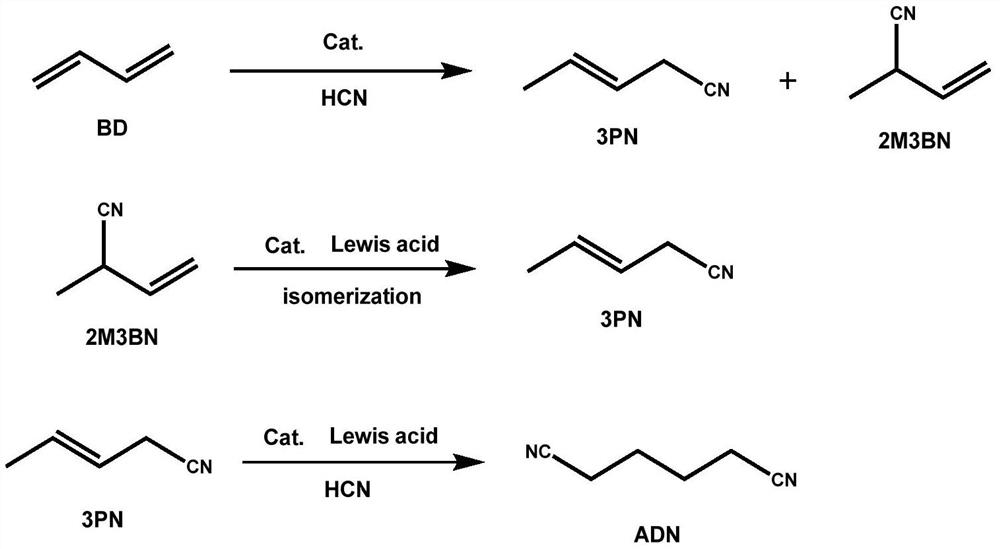2-pentenenitrile isomerization reaction generates the method for 3-pentenenitrile
A technology of pentene nitrile and isomerization, applied in chemical instruments and methods, preparation of organic compounds, organic chemistry, etc., can solve the problems of catalyst deactivation, reduction of catalyst activity and service life, etc., to reduce process costs, reduce The effect of separating the burden and shortening the reaction time
- Summary
- Abstract
- Description
- Claims
- Application Information
AI Technical Summary
Problems solved by technology
Method used
Image
Examples
Embodiment 1
[0031] The invention discloses a method for generating 3-pentenenitrile by isomerization reaction of 2-pentenenitrile, comprising the following steps:
[0032] Mix 2-pentenenitrile, nickel, triphenyl phosphite, 1,2-bisdiphenylphosphine ethane, triphenylboron, and benzene in a molar ratio of 30:1:5:5:1:50 Ratio is added to the isomerization reactor, the reaction pressure is set to 0.1Mpa, and the reaction temperature is set to 130°C. During the reaction, nitrogen protection was carried out, mechanical stirring was carried out, and the reaction time was 30 hours. After the reaction was completed, unreacted 2-pentenenitrile and product 3-pentenenitrile were separated by vacuum distillation. The specific process of vacuum distillation is as follows: the temperature at the top of the tower is 30°C, the temperature at the bottom of the tower is 70°C, and the pressure is 3KPa. It was detected and analyzed by a well-known gas chromatography analysis method, and the results were: the ...
Embodiment 2
[0034] The invention discloses a method for generating 3-pentenenitrile by isomerization reaction of 2-pentenenitrile, comprising the following steps:
[0035] Mix 2-pentenenitrile, cobalt, triisooctyl phosphite, 1,1'-binaphthyl-2,2'-bisdiphenylphosphine, ferric chloride, and dimethylformamide at a ratio of 60:1:15 : 10:10:30 molar ratio is added in the isomerization reactor, the control reaction pressure is 0.2Mpa, the reaction temperature is 130 ℃, in the reaction process, carry out nitrogen protection, mechanical stirring, the reaction time is 18 hours, After the reaction, unreacted 2-pentenenitrile and product 3-pentenenitrile were separated by vacuum distillation. The specific process of vacuum distillation is: the tower top temperature is 55°C, the tower bottom temperature is 105°C, and the pressure is 25KPa. It was detected and analyzed by a well-known gas chromatography analysis method, and the results were: the conversion rate of 2-pentenenitrile was 41%, and the sel...
Embodiment 3
[0037] The invention discloses a method for generating 3-pentenenitrile by isomerization reaction of 2-pentenenitrile, comprising the following steps:
[0038] Mix 2-pentenenitrile, copper, diisodecyl phosphite, 1,6-bisdiphenylphosphine hexane, magnesium chloride, and xylene in a molar ratio of 50:1:20:10:5:30 Add it into the isomerization reactor, control the reaction pressure to be 0.5Mpa, and the reaction temperature is 150°C. During the reaction, nitrogen protection is carried out, and mechanical stirring is carried out. The reaction time is 24 hours. The reacted 2-pentenenitrile and the product 3-pentenenitrile are separated. The specific process of vacuum distillation is: the tower top temperature is 40°C, the tower bottom temperature is 90°C, and the pressure is 15KPa. It was detected and analyzed by a well-known gas chromatography analysis method, and the result was: the conversion rate of 2-pentenenitrile was 45%, and the selectivity of 3-pentenenitrile was 85%.
PUM
| Property | Measurement | Unit |
|---|---|---|
| density | aaaaa | aaaaa |
| melting point | aaaaa | aaaaa |
| boiling point | aaaaa | aaaaa |
Abstract
Description
Claims
Application Information
 Login to View More
Login to View More - R&D
- Intellectual Property
- Life Sciences
- Materials
- Tech Scout
- Unparalleled Data Quality
- Higher Quality Content
- 60% Fewer Hallucinations
Browse by: Latest US Patents, China's latest patents, Technical Efficacy Thesaurus, Application Domain, Technology Topic, Popular Technical Reports.
© 2025 PatSnap. All rights reserved.Legal|Privacy policy|Modern Slavery Act Transparency Statement|Sitemap|About US| Contact US: help@patsnap.com


